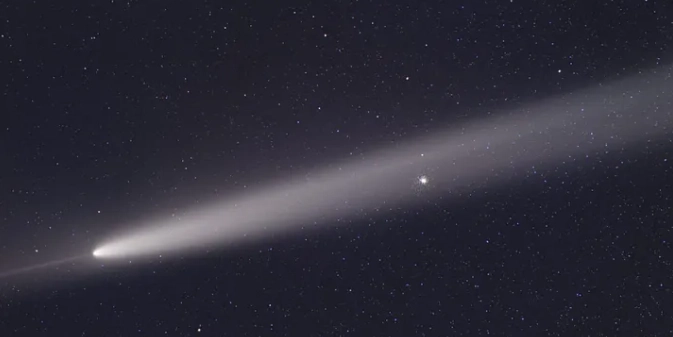The Rise and Fall of Comet ATLAS
“An icy visitor flames out in dramatic fashion”– Sean Walker A comet is a small icy object that orbits the Sun. It’s made of dust, rock, and frozen gases (like water ice, carbon dioxide, and more). I’m sure that everyone’s familiar with this definition of a comet, but today we’re not talking about comets in general but a specific one — ATLAS! Comet ATLAS or C/2024 G3 was named after ATLAS- Asteroid Terrestrial-impact Last Alert System, which was the first to discover it. Comet ATLAS was a 19th-magnitude object. To explain, the magnitude of an object measures its brightness. The brighter the object the lower the number. The comet is also described as having a diffuse coma and a short tail. A coma is a cloud of gas and dust that forms around the nucleus of a comet upon receiving heat from the sun. The gas trail left behind by the comet is its tail. Generally, comets have long blazing tails, but ATLAS did not due to the fact it was falling apart. When ATLAS was discovered in 2024, scientists were immersed with the work of finding key information about it. It was later revealed (in a few days after discovering it) that it passed within 13 million kilometers of the Sun which meant that it would be visible at night in the southern hemisphere from Earth. For the folks present in the north, the comet had been seen near the perihelion (area of the orbit closest to the sun). C/2024 G3 mostly followed prediction and reached 5th magnitude with a tail of 15 arcminutes in length going through the Scorpius. In early 2025 it was reported that ATLAS’s lightning had gone up by 3.7 magnitude in a single day. Two days later its magnitude was recorded to be 1.9 which also meant that it could now be seen using binoculars at night. Observers noted a shadow at the tail most prominent near the nucleus. In a few more days the comet would be visible throughout the naked eye. Mid January, the comet was seen entering the field of SOHO spacecrafts LASCO C3 coronagraph. It also had an estimated magnitude of -3.7, two days later, magnitude was recorded to decrease through the day. Rounding the sun, many got an opportunity to view it from the northern hemisphere. On January 17th, ATLAS was again observed after allegedly surviving the perihelion. This was later proven to be wrong. After passing through the perihelion ATLAS began breaking. Took only a couple of days to wipe the beast, leaving a mere dust trail behind. It was destined to doom as soon as it hit the perihelion. First thought to survive the sun, it eventually succumbed to its fate. Even though brief, ATLAS left a long lasting impression to those who had the chance to witness it.

“An icy visitor flames out in dramatic fashion”– Sean Walker
A comet is a small icy object that orbits the Sun. It’s made of dust, rock, and frozen gases (like water ice, carbon dioxide, and more). I’m sure that everyone’s familiar with this definition of a comet, but today we’re not talking about comets in general but a specific one — ATLAS!
Comet ATLAS or C/2024 G3 was named after ATLAS- Asteroid Terrestrial-impact Last Alert System, which was the first to discover it. Comet ATLAS was a 19th-magnitude object. To explain, the magnitude of an object measures its brightness. The brighter the object the lower the number. The comet is also described as having a diffuse coma and a short tail. A coma is a cloud of gas and dust that forms around the nucleus of a comet upon receiving heat from the sun. The gas trail left behind by the comet is its tail. Generally, comets have long blazing tails, but ATLAS did not due to the fact it was falling apart.
When ATLAS was discovered in 2024, scientists were immersed with the work of finding key information about it. It was later revealed (in a few days after discovering it) that it passed within 13 million kilometers of the Sun which meant that it would be visible at night in the southern hemisphere from Earth. For the folks present in the north, the comet had been seen near the perihelion (area of the orbit closest to the sun). C/2024 G3 mostly followed prediction and reached 5th magnitude with a tail of 15 arcminutes in length going through the Scorpius.
In early 2025 it was reported that ATLAS’s lightning had gone up by 3.7 magnitude in a single day. Two days later its magnitude was recorded to be 1.9 which also meant that it could now be seen using binoculars at night. Observers noted a shadow at the tail most prominent near the nucleus. In a few more days the comet would be visible throughout the naked eye.
Mid January, the comet was seen entering the field of SOHO spacecrafts LASCO C3 coronagraph. It also had an estimated magnitude of -3.7, two days later, magnitude was recorded to decrease through the day. Rounding the sun, many got an opportunity to view it from the northern hemisphere.
On January 17th, ATLAS was again observed after allegedly surviving the perihelion. This was later proven to be wrong. After passing through the perihelion ATLAS began breaking. Took only a couple of days to wipe the beast, leaving a mere dust trail behind.
It was destined to doom as soon as it hit the perihelion. First thought to survive the sun, it eventually succumbed to its fate. Even though brief, ATLAS left a long lasting impression to those who had the chance to witness it.












































































































































































![[The AI Show Episode 156]: AI Answers - Data Privacy, AI Roadmaps, Regulated Industries, Selling AI to the C-Suite & Change Management](https://www.marketingaiinstitute.com/hubfs/ep%20156%20cover.png)
![[The AI Show Episode 155]: The New Jobs AI Will Create, Amazon CEO: AI Will Cut Jobs, Your Brain on ChatGPT, Possible OpenAI-Microsoft Breakup & Veo 3 IP Issues](https://www.marketingaiinstitute.com/hubfs/ep%20155%20cover.png)




































































































































































































































































_incamerastock_Alamy.jpg?width=1280&auto=webp&quality=80&disable=upscale#)
_Brain_light_Alamy.jpg?width=1280&auto=webp&quality=80&disable=upscale#)





























































































![Senators reintroduce App Store bill to rein in ‘gatekeeper power in the app economy’ [U]](https://i0.wp.com/9to5mac.com/wp-content/uploads/sites/6/2025/06/app-store-senate.jpg?resize=1200%2C628&quality=82&strip=all&ssl=1)






















































































